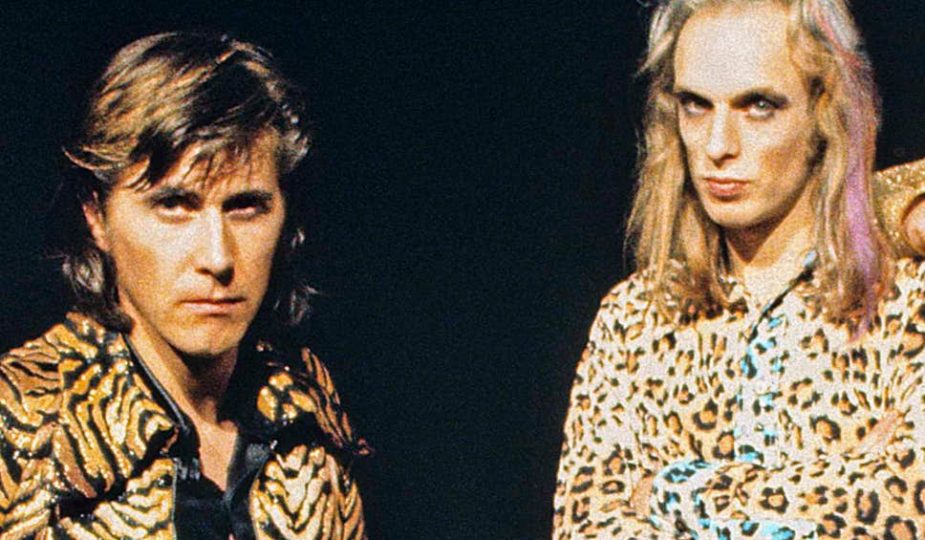
Eno, Ferry, Bowie And The Alien Invasion Of 1972
People had suspected it for years. But in 1972, the release of two albums made it official: there were aliens living on Earth.
The first of these grand announcements may have been the least shocking of the two. David Bowie released The Rise and Fall of Ziggy Stardust. People had long suspected Bowie of being not quite human and he had finally confirmed it. An entire LP explaining the life and ultimate death of an androgynous alien trying to save the world in its final five years of existence. But that was only the beginning. Later in that very same year, another declaration of alien influence upon our planet would be released: the first Roxy Music album.
Roxy Music sounded like no other band of its time. And to this day, the first album, simply titled ROXY MUSIC, sounds as groundbreaking and just plain weird as it did when it was first released. It features references to Humphrey Bogart and the Battle of Britain as if interpreted through some garbled space transmission. Distorted noises and layers of sounds that built upon each other, overlaid with familiar sounding, but not quite right classic song structures. It was influenced as much by front man Bryan Ferry’s art school background as it was by the Velvet Underground. Warhol as music. Music as art. Art as a reflection of a pop culture which never really existed.
Although Roxy Music was Ferry’s band, he had an equally influential alien entity by his side during the creation of the album. His name was Brian Eno, a mysterious figure who would influence music for decades to come. In the early days of Roxy Music, Eno was not actually considered part of the band. He would sit at the back of the stage, hidden by a stack of electronics or a pair of Revox reel-to-reel tape recorders. These were the devices that he used to create his “treatments” of the group’s songs. In interviews, he repeatedly described himself as “a non-musician.” Only later did Ferry and the others invite him to sit on stage with them as a full member of the band.
It was a decision Ferry would come to regret. Audiences immediately took to the odd looking figure of Eno and his electronic wizardry. For all Ferry’s Elvis looks and his heart-melting voice, his dominance of the band was immediately threatened. Something which hit a boiling point during the tour for the second Roxy Music album, For Your Pleasure (1973). Fans, actually, had the audacity to chant “Eno!” “Eno!” “Eno!” while Ferry was performing- Eno would leave the band shortly afterward.
Bowie, Ferry and Eno continued their global domination throughout the seventies. Bowie would form Ziggy into an off-stage persona that was so strong, that he claimed in some interviews he had trouble separating the “real” him from the character. As seen in the documentary of the final tour by D.A. Pennebaker, Ziggy did officially die. However, traces of him clearly remained within Bowie’s next creation, Aladdin Sane, Ziggy’s more hedonistic, drug using, unofficial cousin.
Ferry and Roxy Music would put out albums without Eno over the next decade containing brilliant, often catchy songs of love and yearning. One of the best of these albums is Siren, released in 1975. Not as obviously groundbreaking as the first two Roxy Music albums, Siren was still undeniably breezy and breathtaking. It contained the hits “Both Ends Burning” and “Love is the Drug” among other memorable songs.
It was also notable for the woman featured on its cover, American model Jerry Hall. She would become Ferry’s girlfriend, and remain so for two years until she was stolen away by Mick Jagger. Jagger and Hall would get married, have kids and stay together for over twenty years.
Eno put out four notable solo albums during this same period. At least one of those albums, Here Come The Warm Jets (1974), is as bizarre and innovative as the first two Roxy albums. It’s easy to imagine that Eno assumed this was the direction he thought Roxy Music was headed before Ferry started to solidify his domination of the group. Songs like “Baby’s On Fire” and “Needle in the Camel’s Eye” are particular stand outs.
But Eno never seemed content with one definitive style and eventually moved on to a far different sound. In fact, he would team up with that other being from beyond, Bowie, to work on three more highly-influential albums, beginning in 1977.
Those three albums Low (1977), Heroes (1977), and Lodger (1979) are credited for being major influences on not one, but two musical directions. The first and more known is that Eno and Bowie created entire album sides of spacey, ambient music that truly challenged what music could be, or was even for. The second influence was the spare, stripped-down post-punk/post-rock leanings of songs like “Always Crashing in the Same Car” and “Breaking Glass.”
I should probably mention that these LPs had another interesting influence. Iggy Pop was David Bowie’s roommate at the time. The two were trying to kick drugs and working on Pop’s solo albums The Idiot (1977) and Lust For Life (1977) during this very same period.
As had been the case with Roxy Music, Eno’s exact role on the Bowie albums is hard to define. He is not, as many people often mistakenly believe, officially listed as the producer of these albums. Tony Visconti, no slackard himself, is given that credit. Visconti not only produced many of Bowie’s greatest albums, he was the man behind T-Rex’ Electric Warrior (1971). But Eno is there. You can hear it. You can feel it.
Eno didn’t stop there. There was a band in New York that he soon took an interest in. They were a bunch of former art students, that at the time were far better at thinking up musical ideas than executing them. Their name was Talking Heads.
David Byrne and company had already put out their first record, ’77. It’s a fine record by any standard. But it would be the next three albums which would take Talking Heads to unforeseen levels of innovation and influence-three albums that all happened to be produced by Brian Eno.
More Songs About Buildings and Food was released in 1978, Fear of Music in 1979, and Remain in Light in 1980. Often dark, often danceable, often a little weird, these three albums have all the traits of Eno. That’s not to say Talking Heads were mere bystanders, not by any means. But it’s clear listening to any of these three albums, that they had more than a little push from somebody to make them into the groundbreaking works they became.
Sadly, these three Gods from Beyond the Stars- Eno, Bowie, and Ferry- would all have tragic ends, artistically speaking. Eno would go on to become famous for his work with bands like U2 and Coldplay. Bowie would find even greater commercial success, but artistic limbo in the 80s, with his radio-friendly mega-hit album Let’s Dance (1983). It was a fate he would spend the remainder of his life trying to recover from.
However, Bryan Ferry may have the saddest tale of all. Over time, the character of the classic crooner he once used as a theatrical device took over his very soul and possessed him. The very fate Bowie had once feared for himself with Ziggy Stardust.
Of course, it’s easy to be harsh when one compares the later achievements of these men with the absolutely incredible accomplishments of their earlier careers. Because of them music changed.
In 1972, three aliens by the names of Bowie, Eno, and Ferry reached out to our planet to show us the way. To push us to try new things and to see music in different ways. Thank you, Space Gods. Our musical world is a better place because of you.
by Kevin Leicinger
(shadowswriter.com)

A great article !. It truly surprised me, it’s a great overall background that portrays the massive influence that these aliens left for music (just Bowie and Eno), at least for me 😆.
I don’t agree that there was a tragic end for Bowie and Eno.
In the case of Bowie; “Let’s Dance”, “Heathen” and “The Next Day” are brilliant albums. And “Blackstar” is a masterpiece (influenced by Boards of Canada, Death Grips and Kendrick Lamar). And in the case of Eno; the album “Apollo” is awesome. Coldplay’s “Viva la Vida” album is the only one I like from them, and it was produced by him. Eno contributed on Slowdive’s shoegaze masterpiece “Souvlaki”, especially on the song “Sing” (one of my favorites). And in the case of U2, “The Unforgettable Fire” is decent album (produced by Eno).
I think the most tragic end was for Ferry ..
Anyway, a great article to enrich the universe of Vinyl Writers!
Fabulous read once again. People forget that Bowie recorded absolute crap throughout the 80s, 90s and 00s. Long live the aliens!
Great overview of a wonderful period for intelligent and Innovative music. I always felt that his lineage continued onto the three albums that Brian Eno made with U2 in the 90s. Achtung Baby, Zooropa, and the passengers project Main stream music never got better than that. In my opinion, those three albums showing the same spirit. Great read!
Great write-up on three of my favorites artists. What a unique time in music history!
Cool article. I’m never sure about the impact Eno had on the band, as Roxy Music perfectly continued after he left. “There’s only room for one non-musician in a band”, that famous Ferry phrase might have been just correct wisdom.
I like all Roxy Music. But you have to admit that it’s very, very different over time. Listen to the first two LPs on a good sound system and you’ll hear all sorts of weird crap happening musically. Like, really weird. After Eno left, Roxy Music became more and more of a Byan Ferry project. Much more traditional, musically. For a long time, that was just fine. Siren, for instance, is a great album. But that path can only be taken so far before it usually hits a dead end. Which is exactly what happened when Ferry went solo. Those early albums with Eno, the first especially, were groundbreaking and innovative in a way that later Roxy would never be again.
Legends. Agreed, Bryan Ferry’s late career gets more unbearable for me with every release. Sad indeed. Nevertheless a fascinating man. Not everybody will get off with his son’s girlfriend! 😂
You know, I gotta say, it really pains me how people think of Ferry now. He was such a huge figure in his own right and then he crapped all over himself in his later years. It kind of reminds me of how Rod Stewart went from being one of the greatest Rock n Roll vocalists of his time to a total joke after the whole disco thing. Ferry deserves far more credit than most people seem willing to give him. (For that matter, so does Rod Stewart. But I guess that’s a subject or a different post.)
Saw your flyer at Third Man Records, great content! Some mindblowing articles on here. Are you connected to the label?
If that question was addressed to me, I’ve never been to Third Man and I’m not connected to it in any way. Glad you are digging Saliha’s site though.
Celebration 🎉❤️